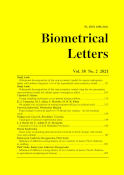
Biometrical Letters Vol. 58(2), 2021, pp. 133-147


Sample size calculation is an integral part of any clinical trial design, and determining the optimal sample size for a study ensures adequate power to detect statistical significance. It is a critical step in designing a planned research protocol, since using too many participants in a study is expensive, exposing more subjects to the procedure. If a study is underpowered, it will be statistically inconclusive and may cause the whole protocol to fail. Amidst the attempt to maximize power and the underlying effort to minimize the budget, the optimization of both has become a significant issue in the determination of sample size for clinical trials in recent decades. Although it is hard to generalize a single method for sample size calculation, this study is an attempt to offer something that might be a basis for finding a permanent answer to the contradictions of sample size determination, by the use of simulation studies under simple random and cluster sampling schemes, with different sizes of power and type I error. The effective sample size is much higher when the design effect of the sampling method is smaller, particularly less than 1. Sample size increases for cluster sampling when the number of clusters increases.

clinical trial, power, sample size, type I error

